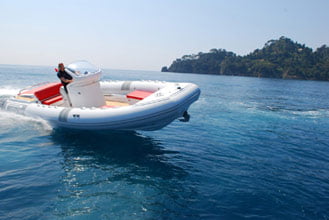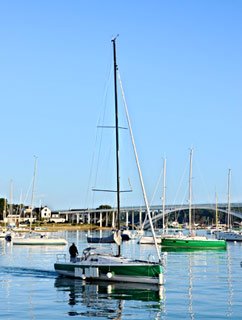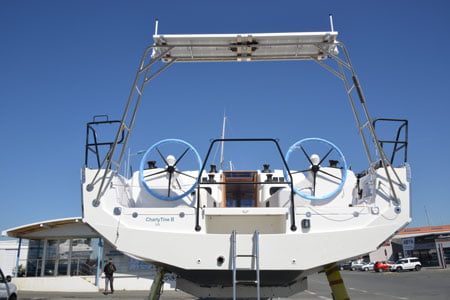Whether your boat is a motor boat or a sailboat, electric or hybrid solutions available nowadays cover a large part of the needs of propulsion energy. Depending on its usage, a sailboat could often combine its installation with other sources of energy (solar panels, hydro generation, wind turbines etc) this is not always the case of motor boats. Your usage will therefore determine your needs in terms of energy productions, and consequently define the kind of electric motorization that your boat needs.
Autonomy difficult to asses
Nowadays, the offer of hybrid and electric motor solutions makes it possible to cover a large part of the needs of pleasure boats with power supplies from 3 KW to 40 KW (6 to 80 HP- double for a catamaran) if you stay in low voltage (48V) or a lot more if you choose high voltage.
Cf. Our article on “Choosing the power necessary to motorize your boat”
But the question of self sufficiency is more complex because it depends on:
- The storage capacity of the battery pack, for reasons of weight and size but above all for budgetary reasons. The price of the kWh of a good lithium battery with BMS is 800/1000 euross.
- The possibility of producing energy on board: solar panels, wind turbines, and especially hydro generation (production of energy by propeller).
- The possibility of having access or not to another means of propulsion: the sail.
- The cruising speed wanted. The power is proportional to the cube of speed !
Motor boats often have little space

Oceanvolt Pirelli 880 we understand therefore that for motor boats, a motorization 100% electric will be particularly suitable for boats with heavy displacement or semi planing hulls such as small tenders, small fishing boats and for river navigation, or one day trips.
- For passenger boats, on short trips with the possibility to recharge during boarding, a solution 100% electric is possible. On the contrary, a generator will be added.
- More information on our page about the different solutions for electric or hybrid motors for passenger boats
- For motor boats with semi-planing hulls or heavy displacement, it is also possible to opt for a solution 100% electric or hybrid: an electric motor to go out or enter the port, access the mooring place and internal combustion engines to navigate at fast speed in open sea..
- More information on our page about our solutions for electric motorization of motor boats
- For tenders, technological progress and the improvement of the capacity of Lithium batteries allow you to have light, reliable and powerful electric motors.
- More information on our page about solutions for electric motors for boat dinghies and zodiac.
Boats that require high power to be able to go fast and dejauger will be limited by the pack of batteries.
For example, for an equivalent 100CV/70 kW. You’ll need 70 kWh of batteries for one hour of navigation at top speed which means high cost and weight. One of the possibilities to explore for these boats is definitely the foil which while sustaining the boat could considerably reduce the fuel consumption.
@
Envoyer une demande
d’estimation de puissance
For a sailboat, the choice of an electric motor is different

The sailboat is by definition a hybrid boat: motor + sail. Consequently the subject of self sufficiency is not the same, since we can often have photovoltaic production and consequent hydro generation. Several configurations are therefore possible depending on the program and the boat.
A choice with no commitment, 100% electric
It is possible to choose a configuration 100% electric that relies solely on its batteries and its energy production to navigate. This requires careful consideration If you do not want to limit yourself to one trip a day.
Several conditions must be met :
- To begin with, you need to have a suitable boat, a boat quickly under sail (even with little wind) and fast when sailing in order to be able to hydro generate, which means produce electricity using the motor as a generator. OCEANVOLT SERVOPROP, for example, allows you to start producing energy from 5 knots and quickly reach 1 kW at 7 knots .
The hydro generation is a key point in self sufficiency. By alternating the periods of sailing and navigating with the motor, the self sufficiency is unlimited. With this kind of boat, 5 hours of sailing can easily cover the consumption of one hour with a motor. For a light and fast catamaran, you can even go one hour of sailing for one hour of motor ! - Calculate your precise consumption onboard (excluding the engine) and little or no use of large consumers (induction plates, coffee maker, electric winches etc) when you do not want to come back to the port regularly.
- Installing as many solar panels as possible, even if they can not cover the consumption of the motor, at least they will cover on board consumption.
- Having a compatible program by getting rid as much as possible of the timing obligations and choosing the right weather slots and its route in order to be able to sail and thus hydro generate. Contrary to what you might think, a long trip program where you can take your time is much better than a summer cruise in the Mediterranean with imposed departure and arrival times.
A light and fast catamaran on which you can install a lot of solar panels (flexible or rigid) which has two motors for twice the hydro generation is the ideal boat. A fast SALONA 46 monohull with 2 OCEANVOLT SERVOPROP engines will also be suitable. Not taking into consideration that the use of the engine at mooring place to charge the batteries through a generator is a non-efficient task and is also not good for the engine.
The electric boat with “range extender”
If you want more peace of mind, you can easily install a small AC generator of 4 or 5 kWs which is very light (70 kgs) to recharge the batteries with the charger at the port during a long period without wind. The generator will also allow you to return to the port at a low speed, if the batteries are completely empty. The speed will be limited in this case by the power of the charger and the generator.
The hybrid boat with DC generator in 48 V
In this case, the power of the generator is chosen to guarantee you the cruising speed wanted even when the batteries are empty. The generator will supply directly the motors with 48V, the excess energy will recharge the batteries. It is a very flexible solution that offers you the possibility of sailing only on electric, with the generator or with both depending on the conditions.
Experience shows that fuel consumption is reduced by 80%. It also offers the possibility to have all the modern comfort on board (heater, induction plate, ice maker, diving unit etc) without making the traditional diesel engine run for hours a day. Not to mention that using the motor at the dock to recharge the batteries through the alternator has a very low efficiency and is very bad for the motor… and for the neighbors, which will not be the case with a generator set.
- See our solution of hybrid motorization for a 40 to 50 feet, less than 18 tons catamaran
The hybrid boat in parallel
In this configuration, the electric motor and the diesel engine are connected to a common transmission. A clutch system allows you to choose between the diesel engine, the electric motor or both at the same time. The solution seems attractive on paper, but it only works on big boats. The price and the weight of the clutch system are not suitable for pleasure boats yet.
The 50/50 for boats with 2 engines.

With a 2 engine boat such as a catamaran, some choose to keep a diesel engine for long cruising distances, and an electric motor to enter and go out of the port as well as for coastal traffic.
An integral type charging system allows you to use the diesel engine’s available, non-used torque to charge the battery pack. The system works very well even if it needs a certain ability for port maneuvering with two engines that do not react the same way. Keep also in mind that you should increase the power of the internal combustion engine in order to move the boat forward with one motor, while recharging the batteries.
In summary, taking into account the average use of pleasure boats, electric or hybrid motors already cover a large part of their needs, but with solutions that are completely suitable to the programs of each one of them.
The electric motor for boats is not a new technology. The first car to exceed 100 KMH is an electric car, the « Jamais contente ». Many means of transportation (boats, trains etc) operate with an electric motor and a generator set which has a superior efficiency than that of the conventional internal combustion engine.
What has changed is the capacity to store the energy by increasingly efficient batteries and the possibility of producing your own green energy: wind, photovoltaic, hydro generation.
Development projects are under construction for batteries or fuel cells which will help accelerate the transition.

